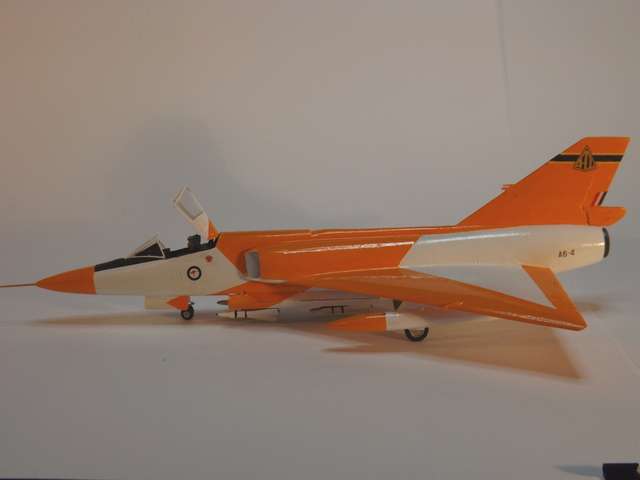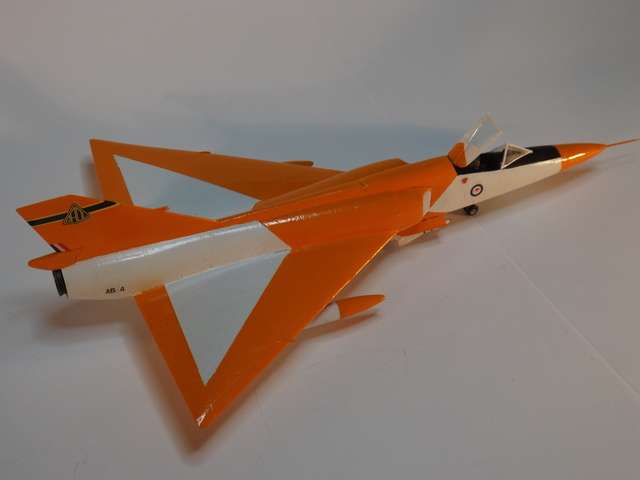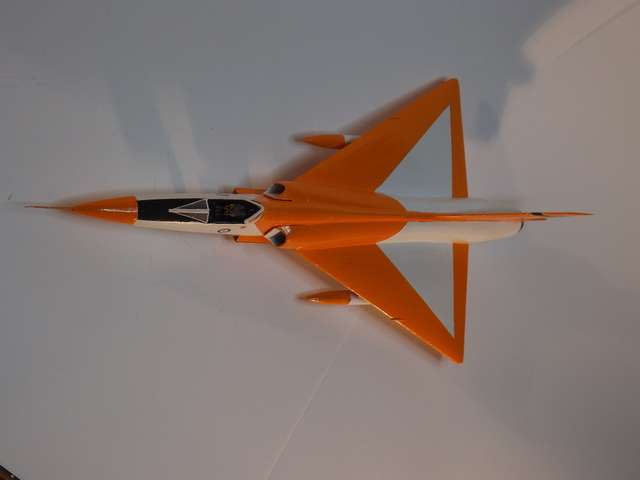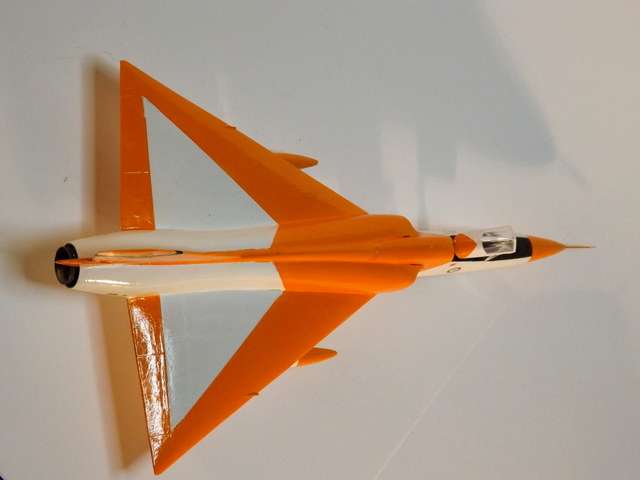The F-106 Delta Dart in RAAF ServiceIn 1958, the RAAF began seeking a replacement for the CF-100 Canuck in Australian service. While the CF-100 had barely been in service 4 years, it was very obvious the days of the straight winged jet interceptor were passing rapidly. The obvious solution was to go with the next, promised Canadian product the CF-105 Arrow. However, just as the RAAF started to express interest in this highly promising aircraft it was cancelled by the Canadian Government. When the RAAF became interested in Britain's TSR2 strike aicraft as a replacement for it's aging Canberra bombers, it was secretly briefed by BAC (British Aircraft Corporation) on the possible development of this aicraft as a fighter, armed with long range air-to-air missiles. Again, however, just as the RAAF was expressing interest in the possible adoption of the TSR2 to fulfil two roles, as both strike and fighter aircraft, this highly promising aircraft was cancelled by the British government. In frustration, the RAAF went cap in hand to the United States. Convair was at that time developing what had been initially known as the F-102B
Delta Dagger and later redesignated as the F-106
Delta Dart.
The F-106 was the ultimate development of the USAF's 1954 interceptor program of the early 1950s. The initial winner of this competition had been the F-102
Delta Dagger, but early versions of this aircraft had demonstrated extremely poor performance, limited to subsonic speeds and relatively low altitudes. During the testing program the F-102 underwent numerous changes to improve its performance, notably the application of the area rule to the fuselage shaping and a change of engine, and the dropping of the advanced MX-1179 fire control system and its replacement with a slightly upgraded version of the MX-1 already in use on subsonic designs. The resulting aircraft became the F-102A, and in spite of being considered barely suitable for its mission, the Air Force sent out a production contract in March 1954, with the first deliveries expected the next year.
By December 1951 the Air Force had already turned its attention to a further improved version, the F-102B. Initially the main planned change was the replacement of the A-model's Pratt & Whitney J57 (itself replacing the original J40) with the more powerful Bristol Olympus, produced under license as the Wright J67. By the time this would be available, the MX-1179 was expected to be available, and was selected as well. The result would be the "ultimate interceptor" the US Air Force wanted originally. However, while initial work on the Olympus appeared to go well, by August 1953 Wright was already a full year behind schedule in development. Continued development did not improve issues, and in early 1955 the US Air Force approved the switch to the Pratt & Whitney J75.
The J75 was somewhat larger than the J57 in the F-102A, and had greater mass flow. This demanded changes to the inlets to allow more airflow, and this led to the further refinement of using a variable-geometry inlet duct to allow the intakes to be tuned to best performance across a wide range of supersonic speeds. This change also led to the ducts being somewhat shorter. The fuselage grew slightly longer, and was cleaned up and simplified in many ways. The wing was slightly enlarged in area, and a redesigned vertical tail surface was used. The engine's 2-position afterburner exhaust nozzle was also used for idle thrust control. The nozzle was held open reducing idle thrust by 40% giving slower taxiing and less brake wear.
The first prototype F-106, an aerodynamic test bed, flew on 26 December 1956 from Edwards Air Force Base, with the second, fitted with a fuller set of equipment, following 26 February 1957. Initial flight tests at the end of 1956 and beginning of 1957 were disappointing, with performance less than anticipated, while the engine and avionics proved unreliable. These problems, and the delays associated with them nearly led to the abandoning of the program, but the US Air Force decided to order 350 F-106s instead of the planned 1,000. After some minor redesign, the new aircraft was delivered starting in October 1959.
On 15 December 1959, Major Joseph W. Rogers set a world speed record of 1,525.96 mph (2,455.79 km/h) in a
Delta Dart at 40,500 ft (12,300 m).
The F-106 was envisaged as a specialized all-weather missile-armed interceptor to shoot down bombers. Similar to the F-102, it was designed without a gun, or provision for carrying bombs, but it carried its missiles in an internal weapons bay for clean supersonic flight. It was armed with four Hughes AIM-4 Falcon air-to-air missiles, along with a single GAR-11/AIM-26A Falcon nuclear-tipped semi-active radar (SAR)-homing missile (which detected reflected radar signals), or a 1.5 kiloton-warhead AIR-2 (MB-2) Genie air-to-air rocket intended to be fired into enemy bomber formations. Like its predecessor, the F-102
Delta Dagger, it could carry a drop tank under each wing. RAAF F-106s of course never flew with nuclear weapons.
The RAAF, despite the numerous limitations of the early versions of the F-106 found it a pleasant aircraft to fly and manoeuvrable as a dog fighter. It's high speed (Mach 2.3) and long combat range (2,900 km) made it an ideal compliment to the new Mirage III fighter-bombers entering service with the RAAF. However, it was extremely expensive. The RAAF which lacked a comprehensive Semi-Automatic Ground Environment (SAGE) network for ground control interception (GCI) missions, the Australian continent being so large and sparsely settled, asked if it was possible to delete this equipment. Convair, scenting the possibility of a sale agreed in the affirmative but stated this would also mean downgrading the radar, as it was an integral part of the Hughes MA-1 AWCS radar system. Instead, they proposed fitting the Westinghouse APQ-72 radar, which was fitted to the F-4B Phantom, which was due to also come into service soon with the USN and was designed also to guide the Hughes Falcon air-to-air missiles. While of similar performance, it was simpler and truth be known, more reliable. The RAAF accepted the proposal, ordering 27 F-106
Delta Dart's (24 F-106C fighters and 3 TF-106B trainers) in 1964, just as
Konfrontasi with Indonesia under Sukarno was starting. These aircraft served with Nos.21 and 22 Squadron, replacing the CF-100 in their inventories. Primarily stationed in Darwin, where they were intended to prevent possible attacks by Indonesia Tu-16
Badger bombers, if conflict had occurred. Teamed with the British Bloodhound missiles, which were also stationed to protect Darwin, they made a formidable defence.
The F-106 served with the RAAF from 1964 until 1983 when replaced by the F/A-18
Hornet.





The aircraft depicted, A6-4 was assigned to the RAAF's ARDU (Aircraft Research and Development Unit) based at Edinburgh based, in South Australia. It wears a distinctive Orange and White "Fanta Can" scheme which was adopted for armament trials. Unusually for an RAAF aircraft, it does not carry any roundals on the upper surfaces. A fact which has been confirmed from the numerous photos taken of the aircraft during the various trials it was engaged on.
The ModelThis is the venerable Hasegawa F-106
Delta Dart kit. Apart from a replacement seat and nose probe, it is stock. It was actually a very nice kit, despite it's obvious age, to put together, with excellent fit and little flash evident. Since building it, I've discovered Lone Star Resins do a replacement set of closed missile bay doors, which I intend to use on my next build of this model. However, the stock open doors and missiles go together quite well. The markings came from a Nova Scale Mirage III set which include the scheme for the Fanta Can Mirage III, which this one is based on.